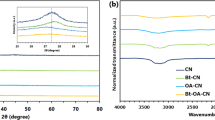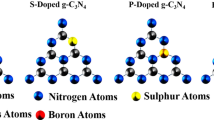Abstract
In this study, visible-light-driven carbon self-doped graphitic carbon nitride photocatalyst was fabricated by a facile method with urea and ammonium citrate, and used for photodegradation of bisphenol A (BPA) in the aqueous environment. The experiments indicated that the prepared photocatalyst (C0.02CN) showed high catalytic activity, and 96.0%, 93.2%, and 95.5% BPA could be photodegraded in 150 min under pH 3, 6, and 11, respectively. The photocatalytic degradation rate (0.018 min−1) and mineralization (27.6%) of C0.02CN for BPA were about 6.7 and 3.5 times higher than those of the g-C3N4 (0.0027 min−1, 7.87%), respectively. C0.02CN had high reusability with a photodegradation efficiency of 84.5% for BPA after 3 cycles. Moreover, C0.02CN introduced additional carbon atoms, which generated C–O–C bonds in the g-C3N4 lattice. In contrast to g-C3N4, carbon doping enhanced the visible light absorption range of C0.02CN, reduced its band gap, and improved the separation efficiency of photogenerated electron–hole pairs. Radical quenching experiment and ESR results revealed that superoxide radicals (•O2−) and photogenerated holes (h+) acted as important parts in the high photodegradation activity under visible light irradiation. This work puts forward a one-pot strategy for the preparation of carbon self-doped g-C3N4, displacing the high-energy consuming and complicated preparation technology with promising industrial applications.









Similar content being viewed by others
Data availability
All data generated or analyzed during this study are included in this published article and its supplementary information file.
References
Tian B, Hu P, Zhao S, Wang M, Hou Y, Jason Niu Q, Li P (2021) Nanofiltration membrane combining environmental-friendly polycarboxylic interlayer prepared from catechol for enhanced desalination performance. Desalination 512. https://doi.org/10.1016/j.desal.2021.115118
Chen M, Guo C, Hou S, Wu L, Lv J, Hu C, Zhang Y, Xu J (2019) In-situ fabrication of Ag/P-g-C3N4 composites with enhanced photocatalytic activity for sulfamethoxazole degradation. J Hazard Mater 366:219–228. https://doi.org/10.1016/j.jhazmat.2018.11.104
Chen H, Xing Y, Liu S, Liang Y, Junli Fu, Wang L, Wang W (2023) Mechanistic insights into efficient photocatalytic H2O2 production of 2D/2D g-C3N4/In2S3 photocatalyst by tracking charge flow direction. Chem Eng J. https://doi.org/10.1016/j.cej.2023.142038
Cydzik-Kwiatkowska A, Zielińska M, Bernat K, Bułkowska K, Wojnowska-Baryła I (2020) Insights into mechanisms of bisphenol A biodegradation in aerobic granular sludge. Bioresour Technol 315:123806. https://doi.org/10.1016/j.biortech.2020.123806
Dhanush C, Sethuraman MG (2021) Independent hydrothermal synthesis of the undoped, nitrogen, boron and sulphur doped biogenic carbon nanodots and their potential application in the catalytic chemo-reduction of Alizarine yellow R azo dye. Spectrochim Acta A Mol Biomol Spectrosc 260:119920. https://doi.org/10.1016/j.saa.2021.119920
Dong Y, Wu D, Chen X, Lin Y (2010) Adsorption of bisphenol A from water by surfactant-modified zeolite. J Colloid Interf Sci 348:585–590. https://doi.org/10.1016/j.jcis.2010.04.074
Geng A, Zhang Y, Xu X, Bi H, Zhu J (2020) Photocatalytic degradation of organic dyes on Li-doped graphitic carbon nitrides. J Mater Sci: Mater Electron 31:3869–3875. https://doi.org/10.1007/s10854-020-02932-8
Hafeez HY, Lakhera SK, Shankar MV, Neppolian B (2020) Synergetic improvement in charge carrier transport and light harvesting over ternary InVO4-g-C3N4/ rGO hybrid nanocomposite for hydrogen evolution reaction. Int J Hydrogen Energy 45:7530–7540. https://doi.org/10.1016/j.ijhydene.2019.05.235
Huang YQ, Wong CKC, Zheng JS, Bouwman H, Barra R, Wahlström B, Neretin L, Wong MH (2012) Bisphenol A (BPA) in China: a review of sources, environmental levels, and potential human health impacts. Environ Int 42:91–99. https://doi.org/10.1016/j.envint.2011.04.010
Huang L, Liu J, Li P, Li Y, Wang C, Shu S, Song Y (2022) CQDs modulating Z-scheme g-C3N4/BiOBr heterostructure for photocatalytic removing RhB, BPA and TC and E. coli by LED light. J Alloy Compd 895:162637. https://doi.org/10.1016/j.jallcom.2021.162637
Kessler FK, Zheng Y, Schwarz D, Merschjann C, Schnick W, Wang X, Bojdys MJ (2017) Functional carbon nitride materials—design strategies for electrochemical devices. Nat Rev Mater 2. https://doi.org/10.1038/natrevmats.2017.30
Lin X, Tran DT, Song M-H, Yun Y-S (2021) Development of polyethyleneimine-starch fibers stable over the broad pH range for selective adsorption of gold from actual leachate solutions of waste electrical and electronic equipment. J Clean Prod 328:129545. https://doi.org/10.1016/j.jclepro.2021.129545
Lin X, Tran DT, Song M-H, Yun Y-S (2022) Development of quaternized polyethylenimine-cellulose fibers for fast recovery of Au(CN)2- in alkaline wastewater: kinetics, isotherm, and thermodynamic study. J Hazard Mater 422:126940. https://doi.org/10.1016/j.jhazmat.2021.126940
Liu J (2016) Effect of phosphorus doping on electronic structure and photocatalytic performance of g-C3N4: insights from hybrid density functional calculation. J Alloy Compd 672:271–276. https://doi.org/10.1016/j.jallcom.2016.02.094
Lu Z, Li M, Chen M, Wang Q, Chun W, Sun M, Gehong S, Wang X, Wang Y, Zhou X, Ye J, Liu T, Rao H (2023) Deep learning-assisted smartphone-based portable and visual ratiometric fluorescence device integrated intelligent gel label for agro-food freshness detection. Food Chem 413:135640. https://doi.org/10.1016/j.foodchem.2023.135640
Ma S, Zhan S, Jia Y, Shi Q, Zhou Q (2016) Enhanced disinfection application of Ag-modified g-C3N4 composite under visible light. Appl Catal B 186:77–87. https://doi.org/10.1016/j.apcatb.2015.12.051
Miao W, Liu Y, Chen X, Zhao Y, Mao S (2020) Tuning layered Fe-doped g-C3N4 structure through pyrolysis for enhanced Fenton and photo-Fenton activities. Carbon 159:461–470. https://doi.org/10.1016/j.carbon.2019.12.056
Mohammad A, Khan ME, Yoon T, Cho MH (2020) Na, O-co-doped-graphitic-carbon nitride (Na, O-g-C3N4) for nonenzymatic electrochemical sensing of hydrogen peroxide. Appl Surf Sci 525:146353. https://doi.org/10.1016/j.apsusc.2020.146353
Ojha DP, Karki HP, Kim HJ (2018) Design of ternary hybrid ATO/g-C3N4/TiO2 nanocomposite for visible-light-driven photocatalysis. J Ind Eng Chem 61:87–96. https://doi.org/10.1016/j.jiec.2017.12.004
Ong W-J, Tan L-L, Ng YH, Yong S-T, Chai S-P (2016) Graphitic carbon nitride (g-C3N4)-based photocatalysts for artificial photosynthesis and environmental remediation: are we a step closer to achieving sustainability? Chem Rev 116:7159–7329. https://doi.org/10.1021/acs.chemrev.6b00075
Qin Y, Ding Y, Tang H (2016) Highly efficient visible-light photocatalytic activity of graphitic carbon nitride prepared from melamine-thiourea molecular composite. J Environ Chem Eng 4:4374–4384. https://doi.org/10.1016/j.jece.2016.09.029
Rahman MS, Adegoke EO, Pang M-G (2021) Drivers of owning more BPA. J Hazard Mater 417:126076. https://doi.org/10.1016/j.jhazmat.2021.126076
Sabour A, Helou ME, Roger-Leroi V, Bauer C (2021) Release and toxicity of bisphenol-A (BPA) contained in orthodontic adhesives: a systematic review. Int Orthod 19:1–14. https://doi.org/10.1016/j.ortho.2020.11.002
Sankarapillai Mahesh C, Lekshmi L, Renuka KD, Joseph K (2016) Simple and cost-effective synthesis of fluorescent graphene quantum dots from honey: application as stable security ink and white-light emission. Part Part Syst Charact 33:70–74. https://doi.org/10.1002/ppsc.201500103
Sharabati MA, Abokwiek R, Al-Othman A, Tawalbeh M, Karaman C, Orooji Y, Karimi F (2021) Biodegradable polymers and their nano-composites for the removal of endocrine-disrupting chemicals (EDCs) from wastewater: a review. Environ Res 202:111694. https://doi.org/10.1016/j.envres.2021.111694
Shu K, Chen F, Shi W, Guo F, Tang Y, Ren H, Li M (2020) Construction of DyVO4/nitrogen deficient g-C3N4 composite for enhanced visible-light photocatalytic activity for tetracycline degradation. Mater Res Bull 124:110766. https://doi.org/10.1016/j.materresbull.2020.110766
Tang Y, Li Y, Zhan L, Wu D, Zhang S, Pang R, Xie B (2022) Removal of emerging contaminants (bisphenol A and antibiotics) from kitchen wastewater by alkali-modified biochar. Sci Total Environ 805:150158. https://doi.org/10.1016/j.scitotenv.2021.150158
Vandenberg LN, Hauserb R, Marcus M, Olead N, Welshons WV (2007) Human exposure to bisphenol A (BPA). Reprod Toxicol 24:139–177. https://doi.org/10.1016/j.reprotox.2007.07.010
Waheed UK, Zhou P, Qin L, Alam A, Ge Z, Wang Y (2022) Solvent-free synthesis of nitrogen doped carbon dots with dual emission and their biological and sensing applications. Mater Today Nano 18:100205
Wang Y, Tan G, Liu T, Su Y, Ren H, Zhang X, Xia A, Lv L, Liu Y (2018) Photocatalytic properties of the g-C3N4/{010} facets BiVO4 interface ZScheme photocatalysts induced by BiVO4 surface heterojunction. Appl Catal B 234:37–49. https://doi.org/10.1016/j.apcatb.2018.04.026
Wang Q, Zhang L, Guo Y, Shen M, Wang M, Li B, Shi J (2020) Multifunctional 2D porous g-C3N4 nanosheets hybridized with 3D hierarchical TiO2 microflowers for selective dye adsorption, antibiotic degradation and CO2 reduction. Chem Eng J 396:125347. https://doi.org/10.1016/j.cej.2020.125347
Wang Y, Hu X, Li W, Huang X, Li Z, Zhang W, Zhang X, Zou X, Shi J (2020) Preparation of boron nitrogen co-doped carbon quantum dots for rapid detection of Cr(VI). Spectrochimica Acta Part A: Molecular and Biomolecular Spectroscopy 243:118807. https://doi.org/10.1016/j.saa.2020.118807
Wang X, Ren Y, Li Y, Zhang G (2022) Fabrication of 1D/2D BiPO4/g-C3N4 heterostructured photocatalyst with enhanced photocatalytic efficiency for NO removal. Chemosphere 287:132098. https://doi.org/10.1016/j.chemosphere.2021.132098
Wu M, He X, Jing B, Wang T, Wang C, Qin Y, Ao Z, Wang S, An T (2020) Novel carbon and defects co-modified g-C3N4 for highly efficient photocatalytic degradation of bisphenol A under visible light. J Hazard Mater 384:121323. https://doi.org/10.1016/j.jhazmat.2019.121323
Xiao C, Wang L, Zhou Q, Huang X (2020) Hazards of bisphenol A (BPA) exposure: a systematic review of plant toxicology studies. J Hazard Mater 384:121488. https://doi.org/10.1016/j.jhazmat.2019.121488
Xing J, Huang X, Yong X, Li X, Li J, Wang J, Wang N, Hao H (2023) N-doped synergistic porous thin-walled g-C3N4 nanotubes for efficient tetracycline photodegradation. Chem Eng J 455. https://doi.org/10.1016/j.cej.2022.140570
Zhang S, Liu Y, Gu P, Ma R, Wen T, Zhao G, Li L, Ai Y, Hu C, Wang X (2019) Enhanced photodegradation of toxic organic pollutants using dual-oxygendoped porous g-C3N4: mechanism exploration from both experimental and DFT studies. Appl Catal B 248:1–10. https://doi.org/10.1016/j.apcatb.2019.02.008
Zhang L, Rao L, Wang P, Shi Z, Wang P (2021) Superhydrophobic self-floating TiO2-silicone composite aerogels and their air–liquid-solid triphase photocatalytic system. Appl Surf Sci 536. https://doi.org/10.1016/j.apsusc.2020.147726
Zhou Y, Zhang L, Huang W, Kong Q, Fan X, Wang M, Shi J (2016) N-doped graphitic carbon-incorporated g-C3N4 for remarkably enhanced photocatalytic H2 evolution under visible light. Carbon 99:111–117. https://doi.org/10.1016/j.carbon.2015.12.008
Zhou G, Cao Y, Jin Y, Wang C, Wang Y, Hua C, Wu S (2020) Novel selective adsorption and photodegradation of BPA by molecularly imprinted sulfur doped nano-titanium dioxide. J Clean Prod 274:122929. https://doi.org/10.1016/j.jclepro.2020.122929
Zhu Y, Wang T, Xu T, Li Y, Wang C (2019) Size effect of Pt co-catalyst on photocatalytic efficiency of g-C3N4 for hydrogen evolution. Appl Surf Sci 464:36–42. https://doi.org/10.1016/j.apsusc.2018.09.061
Funding
This study was supported by the National Natural Science Foundation of China (22106184).
Author information
Authors and Affiliations
Contributions
Ling Lei: conceptualization, methodology, investigation, formal analysis, visualization, and writing—original draft; Xi He: data curation, investigation, and visualization; Xiaoyu Lin: resources and data curation; Chen Yang: data curation; Yufeng Zhao: validation; Longzhe Cui: supervision; Guiping Wu: writing—reviewing and editing.
Corresponding author
Ethics declarations
Ethical approval
Not applicable.
Consent to participate
Not applicable.
Conflict of interest
The authors declare no competing interests.
Additional information
Responsible Editor: Sami Rtimi
Publisher's note
Springer Nature remains neutral with regard to jurisdictional claims in published maps and institutional affiliations.
Supplementary Information
Below is the link to the electronic supplementary material.
Rights and permissions
Springer Nature or its licensor (e.g. a society or other partner) holds exclusive rights to this article under a publishing agreement with the author(s) or other rightsholder(s); author self-archiving of the accepted manuscript version of this article is solely governed by the terms of such publishing agreement and applicable law.
About this article
Cite this article
Lei, L., He, X., Lin, X. et al. Preparation of carbon self-doped g-C3N4 for efficient degradation of bisphenol A under visible light irradiation. Environ Sci Pollut Res 30, 65328–65337 (2023). https://doi.org/10.1007/s11356-023-26928-z
Received:
Accepted:
Published:
Issue Date:
DOI: https://doi.org/10.1007/s11356-023-26928-z




